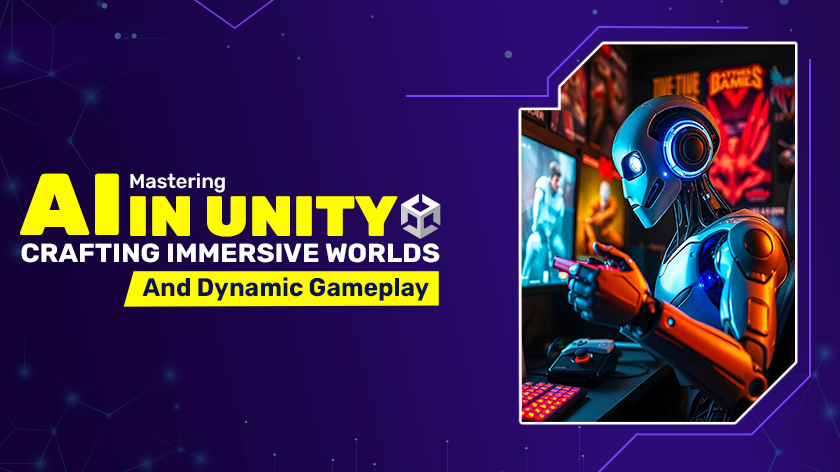The gaming industry has noticed a significant transformation due to artificial intelligence (AI), particularly when integrated with powerful platforms like Unity. By leveraging AI, developers can breathe life into virtual worlds, creating more dynamic, immersive, and interactive experiences. In this blog, we’ll explore how AI can be applied in Unity to elevate gameplay, design intelligent characters, and build highly detailed, responsive environments. Whether you’re a beginner or an experienced developer, mastering AI in Unity will enhance your game development expertise.
1. The Role of AI in Game Development
AI in gaming isn’t just about creating smarter enemies or challenging gameplay—it’s about making the entire game environment reactive to player behavior. From dynamic NPCs (non-player characters) to complex decision-making systems, AI adds depth and interactivity that engage players on a deeper level. In Unity, developers can integrate AI to enhance everything from navigation to enemy tactics, providing more lifelike and unpredictable gameplay.
2. Key AI Components in Unity
Unity offers several tools and features to implement AI, including:
- NavMesh: Unity’s pathfinding system allows developers to create characters that navigate the game world intelligently. With NavMesh, characters can avoid obstacles, find the shortest path to targets, and react to the environment in real-time.
- Behavior Trees: Used to define complex decision-making processes, behavior trees allow NPCs to perform different actions based on game scenarios. They enable a structured approach to character behavior, such as deciding whether an enemy should attack, flee, or hide.
- Machine Learning Agents (ML-Agents): Unity’s ML-Agents Toolkit enables the use of reinforcement learning to train agents. These agents can learn behaviors through trial and error, adapting to different scenarios to create unpredictable and dynamic gameplay experiences.
3. Creating Immersive Worlds with AI
AI can greatly enhance world-building by making environments interactive and reactive. For instance, in open-world games, AI can generate dynamic events based on player actions, such as triggering an enemy ambush or environmental changes like weather shifts. Unity’s AI tools allow developers to create environments that respond and adapt to the player’s choices, leading to a more immersive experience.
- Procedural Generation: With AI-driven procedural generation, developers can create vast and varied landscapes, dungeons, or levels without having to design every element manually. The AI can adaptively generate new content based on the player’s progress, ensuring that each playthrough feels unique and engaging.
- Adaptive Sound and Lighting: AI in Unity can also manage real-time changes in soundscapes and lighting, adjusting the atmosphere of the game world to match the mood and intensity of the player’s current situation. For example, during tense moments, the AI can increase the intensity of music or change lighting to heighten the player’s emotional experience.
4. Dynamic Gameplay through AI
AI can drastically change gameplay by allowing NPCs and environments to react to player strategies and adapt in real time. This creates more challenging and varied gaming experiences. Here’s how AI contributes to dynamic gameplay:
- Smarter Enemies: In traditional games, enemy behavior can feel static or repetitive. With AI, enemies can adapt to player strategies, coordinate attacks, and even retreat when outmatched. Unity’s ML-Agents Toolkit allows enemies to “learn” from player actions, making gameplay more unpredictable and exciting.
- Collaborative AI for Multiplayer Games: In multiplayer scenarios, AI can assist or compete with players, adjusting its difficulty based on player performance. This ensures that each player gets a tailored experience, whether they’re facing off against AI opponents or cooperating with AI-controlled allies.
5. Optimizing AI Performance in Unity
AI can be computationally expensive, especially in large or complex game worlds. Unity provides several optimization techniques to ensure smooth performance:
- Level of Detail (LOD): By reducing the complexity of AI behaviors for distant or off-screen NPCs, developers can save processing power without sacrificing the player experience.
- Pooling Systems: Object pooling allows developers to reuse objects in memory, reducing the overhead of constantly creating and destroying AI-controlled entities.
6. Future of AI in Unity
As AI technology continues to evolve, Unity remains at the forefront of integrating cutting-edge AI features. With the increasing popularity of machine learning, future Unity projects will likely incorporate even more advanced AI systems, leading to more personalized, intelligent, and immersive gameplay experiences.
Conclusion
For developers who want to make more dynamic and compelling environments, mastering AI in Unity is essential. AI can improve every aspect of game creation, including creating responsive surroundings, intelligent NPCs, and gameplay optimization. By using Unity’s integrated AI tools and keeping up with current developments, creators may expand the possibilities for game creation. AI will become more and more important in gaming as technology develops, making it a necessary ability for developers hoping to provide engaging, cutting-edge gaming experiences.
Ready to bring your game development to the next level with AI and Unity? Start experimenting with Unity’s powerful AI tools today and craft immersive, dynamic worlds that captivate players. Partner with Xceltec to turn your vision into reality and elevate your games to new heights!
For more information: https://www.xceltec.com/
 :
https://in.pinterest.com/xceltec0192/
:
https://in.pinterest.com/xceltec0192/












